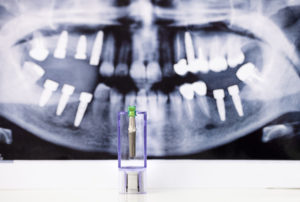 Dental implants are an excellent way to permanently resolve tooth loss. By surgically implanting a prosthetic tooth, you’ll regain the appearance and function of a natural tooth. However, in order to benefit from implants, you need to have adequate bone density in the jaw to support the implant. As you live with untreated tooth loss, your jawbone will naturally begin to deteriorate. If you’ve had tooth loss for some time, you may not have enough bone left to support the implants. If you’re lacking the support needed for implants, bone grafting may be an option for you.
Dental implants are an excellent way to permanently resolve tooth loss. By surgically implanting a prosthetic tooth, you’ll regain the appearance and function of a natural tooth. However, in order to benefit from implants, you need to have adequate bone density in the jaw to support the implant. As you live with untreated tooth loss, your jawbone will naturally begin to deteriorate. If you’ve had tooth loss for some time, you may not have enough bone left to support the implants. If you’re lacking the support needed for implants, bone grafting may be an option for you.
Why Do I Need Bone Support?
When you have tooth loss, your underlying bones are no longer stimulated. As a result, the body begins to send vital nutrients to other areas of the body, causing the jawbone to deteriorate. Implants help stimulate the bone to revitalize growth, but if there isn’t enough bone left in the first place, you will require bone grafting to support the implant.
Types of Bone Grafts
Depending on your level of bone loss and type of implant needed, there are a number of bone grafts available. Upon an evaluation and analysis of your individual needs, we will determine the type of grafting procedure that will best fit your needs.
Sinus Lift—For those who have decreased bone density on the upper jaw, a sinus lift is often used to attach bone to increase the density of the upper jaw by filling the maxillary sinus.
Ridge Expansion—When tooth loss occurs, your bone will first lose its width, and then its height. With a ridge expansion, the width of the bone will be restored by inserting new bone to the top of the jaw.
Distraction Osteogenesis—Unlike a ridge expansion, this procedure is used to increase the height of the bone. We use metal posts that are inserted into the bone. Then, they are gradually moved away from one another to allow new bone to grow in between. This is a very slow process but effective in the end.
Nerve Repositioning—The lower jaw contains the inferior alveolar nerve, which allows sensations in the mouth and chin. If a lot of bone loss has occurred, the nerve will need to be repositioned to allow the implants to be placed in the correct position to allow the proper space for the nerve.
Bone Grafts for Dental Implants
While the procedures may seem a bit scary, they are fairly common procedures. Often performed under local anesthesia, a small amount of bone is often removed from the chin, at which point it’s surgically inserted under the gum to the site needing extra bone support. The gum will be reclosed and the bone will natural heal with the help of small titanium screws.
If you have been told you aren’t a candidate for implants due to decreased bone, you aren’t out of options. Olberding Dental will provide the bone grafts you need to benefit from implants. Call us today at (402) 817-0098 to schedule a consultation.
